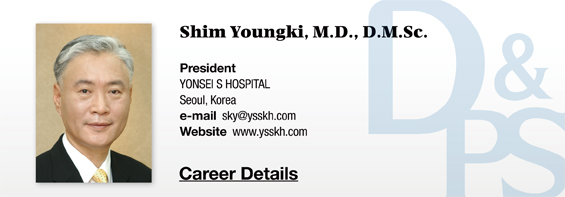Complications of sclerotherapy
The most important question regarding sclerotherapy of the foot is whether the medial retromalleolar varicose veins can be safely treated. In this area, the posterior fibular artery and posterior fibular vein run very close to the surface of the skin. Therefore, injecting the sclerosing agent into the artery by a slight miscalculation can lead to an extensive ulcer of the foot. Even a para-arterial injection can also cause similar degree of skin damage.
Sclerotherapy of areas below the ankle requires special caution not to inject the sclerosing agent into the artery. The inguinal area with the SFJ or the bank of the knee with the SPJ of the small saphenous vein locate very close to the artery. Therefore, in order to avoid injecting the artery, always pull the plunger of the syringe to closely observe the color of the regurgitated blood, pressure and pulse, etc. as well as check the sound of the injection site with doppler ultrasound during injection. It is also advisable to visualize the injection site with ultrasound.
Postsclerotherapy complications
The disadvantages of sclerotherapy include pain during treatment (depending on the agent), allergic reaction, phlebitis, skin necrosis, skin discoloration, angiogenesis, etc. Clinical experience data for each agent are as following.
Based on many years of use, the rate of allergic reaction to polidocanol was 0.01%. The reason this drug has low antigenicity is that it does not contain benzene nucleus and para-amino group, which are common allergens, and consists of lone free alcohol group. Dexo Labs (product manufacturer in Nanterre, France) recommends not using polidocanol in patients with allergic diseases such as asthma. Allergic reactions to polidocanol is reported to be more rare compared to sodium tetradecyl sulfate.
Skin necrosis is also rare. Skin necrosis did not occur with dermal injection of 0.1ml 1% polidocanol. At concentrations used in telangiectasia (less than 1%), the rate of epidermal necrosis was lower than with injections of hypertonic saline solution or sodium tetradecyl sulfate.
[Advertisement] Tulip(Skin Tightening & Lifting) – Manufacturer: DANIL SMC(www.danilsmc.com)
Postsclerothrapy Hyperpigmentation
a. Hyperpigmentation occurred in about 30-80% of patients given STS, 10-30% of patients treated with hypertonic saline solution and 35% of patients given polidocanol, etholamine oleate and iodine. This is caused by inflammatory reaction and and hemosiderin deposition. In 30% of cases with telangiectasia or superficial veins, hyperpigmentation in the form of stipes remain after sclerotherapy due to hemosiderin from destroyed red blood cells of the thrombus. In the past, melanin was thought to be involved but biopsy of the hyperpigmented area revealed hemosiderin to be the culprit. To treat this pigmentary lesion, a whitening agent (hydroquinone), cryotherapy (liquid nitrogen, solid carbon dioxide) and chemical peeling (20~25% TCA), etc. have been tried to no avail. Duffy reported that Baker’s solution applied for 2-5 seconds and rubbed with 4×4 gauze can be tried in patients with hyperpigmentation continuing for over a year.
It is crucial to communicate to the patients that permanent pigmentation can occur although the likelihood is very little. Cacciatore reported that the incidence of pigment deposition after polidocanol sclerotherapy is 10.7% and Goldman et al. reported almost 30% of incidence with polidocanol, similar to hypertonic saline solution or sodium tetradecyl sulfate. Hyperpigmentation is more severe and persistent with a higher concentration slcerosing agent. Hyperpigmentation following sclerotherapy was resolved in 6 months to 2 years but persisted for over 2 years in 5% of patients.
The recent introduction and wide use of Q-switched Laser (Nd:YAG, Alexandrite, Ruby) in Korea has allowed selective destruction of pigments. I have tried Q-switched Alexandrite Laser in patients with persistent pigmented lesions and found that the lesion improved greatly to almost completely disappear.
b. Foot edema occured in 2-5% of patients. Foot edema was particularly more common in patients with history of edema and a large dose injection of sclerosing agent in the foot and ankle area. The incidence is similar between polidocanol and hypertonic saline solution.
c. Asymptomatic thrombosis refers to dark blue linear blood clots appearing 1 week or longer after slcerosing agent injection. It is common after sclerotherapy of thick veins (3-4mm). Asymptomatic thrombosis is associated with continuous mild pain. For treatment, make a stab incision into the skin and blood vessel with a No.11 scalpel (stab incision) and extract the linear blood clots with cotton swabs applied at both sides of the incision. After thrombus extraction, apply topical antibiotics over the wound to remove the pigmented lesion and resolve pain.
Lower limb venous blood flows inward, whereas, 50% of the perforating veins of the foot lack valves and blood can be regurgitated toward the epidermis. For this reason, caution is needed in high-concentration sclerotherapy in the foot as it can easily induce thrombosis of the deep veins.
d. Superficial thrombophlebitis can occur at the rate of 0.5%. In particular, it is more likely when treating veins 3-5mm thick or larger and when insufficient compression is applied. It can occur 1-2 months after sclerotherapy in some cases. Treatments include non steroidal anti inflammatory drugs, antibiotics, compression therapy, and hot pack.
-To be continued-





















